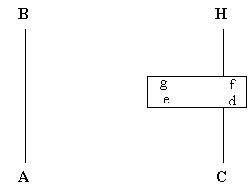
This course is run at the The University of Nottingham within the School of Computer Science & IT. The course is run by Graham Kendall (EMAIL : gxk@cs.nott.ac.uk)
Consider this diagram.
 |
If you are an ant trying to get from A to B then there is no problem. You simply
head in a straight line and away you go. And all your friends do likewise.
But, now consider if you want to get from C to H. You head out in a straight
line but you hit an obstacle. The decision you have to make is, do you turn
right or left?
The first ant to arrive at the obstacle has a fifty, fifty chance of which
way it will turn. That is whether it will go C,d,f,H or C, e, g, H.
Also assume that ants are travelling in the other direction (H to C). When they reach the obstacle they will have the same decision to make. Again, the first ant to arrive will have a fifty, fifty chance or turning right or left.
But, the important fact about ants is that as they move they leave a trail
of pheromone and ants that come along later have more chance of taking a trail
that has a higher amount of pheromone on it.
So, by the time the second, and subsequent, ants arrive the ants that took
the shorter trail will have laid their pheromone whilst the ants taking the
longer route will still be in the process of laying their trails.
Over a period of time the shorter routes will get higher and higher amounts
of pheromone on them so that more and more ants will take those routes.
If we follow this through to its logical conclusions, eventually all the ants
will follow the shorter route.
| Previous Page | Index Page | Next Page |
Last Updated : 26/01/2001